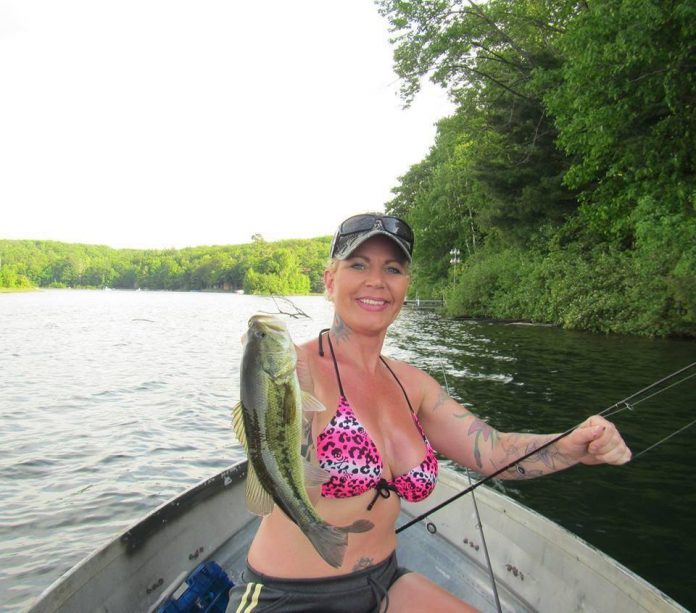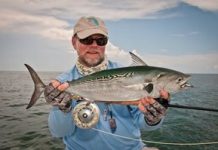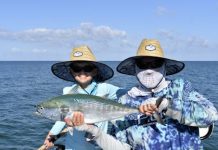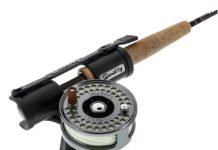By CAPT. PAT DAMICO, CapMel.com Fly Fishing Editor
With the, “dog days of summer,” upon us, where can we have some consistent fly rod action? Most of my articles deal with saltwater fishing, but we are fortunate to have a variety of freshwater ponds and lakes throughout Florida that all seem to harbor an assortment of panfish and bass. Even if never stocked, they all eventually contain cooperative, scrappy panfish that are not especially selective when it comes to supplementing their diet. If you are new to fly fishing, there isn’t a better way to get plenty of action in a short period of time. Children will love the experience and will look forward to their next outing. Let’s go over some requirements for consistent success.
Equipment can be very simple. Any four to six weight fly rod with a floating weight forward line will be adequate. Shorter rods will be more trouble free if there are a lot of overhanging trees and vegetation along the shoreline that you must walk around or cast under. I like tapered leaders of between seven and nine feet with a six pound tippet. A variety of panfish are usually available, mostly members of the bluegill family, and also some crappie. Largemouth bass will be present and will hit your panfish offerings. More than a few big bass have been taken with small lures. Look around your chosen pond and see what food is available. Crickets, grasshoppers, ants, a variety of flies and spiders, beatles, small baitfish, frogs, and any other living things that reside in or near the water will provide food for these smaller predators. There is nothing more satisfying than hearing the telltale smack as they engulf an offering on the surface. Most of my selection will include floating flies. Poppers that are very tiny in sizes from ten to six are perfect. White, yellow, black and chartreuse will be more than enough colors. Bodies of cork, deerhair, balsa wood and foam are available. Foam would get my preference for ease of casting and durability. The heads can be flat, cup shaped, for more surface disturbance, or pointed, so that they slide through grass and other obstacles. A few with weed guards would be a good idea. This is especially helpful when your presentation lands on shore, a dock, lilly pads or a stump. When gently teased it will fall into the water frequently eliciting an immediate strike. A few wooly buggers and streamers will fulfill your subsurface needs.
Now that we are equipped, where will we fish? A lot will depend on whether you will walk the shoreline, wade, or use some type of boat. For our purposes, lets think about small ponds that will be fished from shore. The equipment we discussed will be adequate in either case. Besides our state, county, and city ponds and lakes, there are many small ponds in developments and golf courses that are private but open to residents. They are rarely fished and are usually very productive. Farm ponds in the country can be real honey holes. Look for one that has a variety of depths and structure. Areas of shade, and deeper water will attract fish during the warmer parts of the day. The shallows will be the places to cast early in the morning and evening. Docks and other wood structure are magnets and should be carefully plied with your offerings. If walking, you must be able to get close enough to cast without dressing trees with your flies. With a little legwork, you will discover some ponds will have larger fish than others and these will become your favorites. Gators and snakes should also be a concern.
Most fish will be close to the shoreline. I like to cast parallel to the shore. Panfish usually respond best to a very slow presentation. This is a good place to practice your weak hand casting skills. A good way to fish a top water offering is to let all the rings disappear after it hits the surface before imparting any movement. This represents a stunned, easy meal. Unlike saltwater fishing, a motionless fly is frequently engulfed. If nothing happens, a slight twitch should be the first movement. A few aggressive twitches can now be made before making the next cast. Keep your rod close to the water’s surface using your line hand to create most action to the fly. Wet flies should be allowed to sink a little before starting a very slow retrieve. When fishing deeper water, use a countdown method to locate cooperative fish. Once their level is attained, repeat the same count to stay with the fish. They will frequently suspend or locate over some submerged structure.
If you enjoy eating fresh fish, some panfish fillets will be a welcome addition to your table and will not hurt, but usually improve the fishery. Skinless fillets, rolled in your favorite coating before frying are great table fare. There isn’t a better way to get the whole family interested in fishing. Unlike much of our other fishing, a rigged rod in the car and a small container with flies and leader material can be brought into action in a few minutes. This is a great way to spend an evening. Pound for pound, panfish are real fighters and will bring a smile to even the most sophisticated fly rod purist.
Capt. Pat Damico
Fly Fishing Editor
www.captpat.com
- Capiains Corner. Damico - December 26, 2023
- Pat Damico - December 21, 2023
- CaptainsCorner: Pat Damico - November 27, 2023












